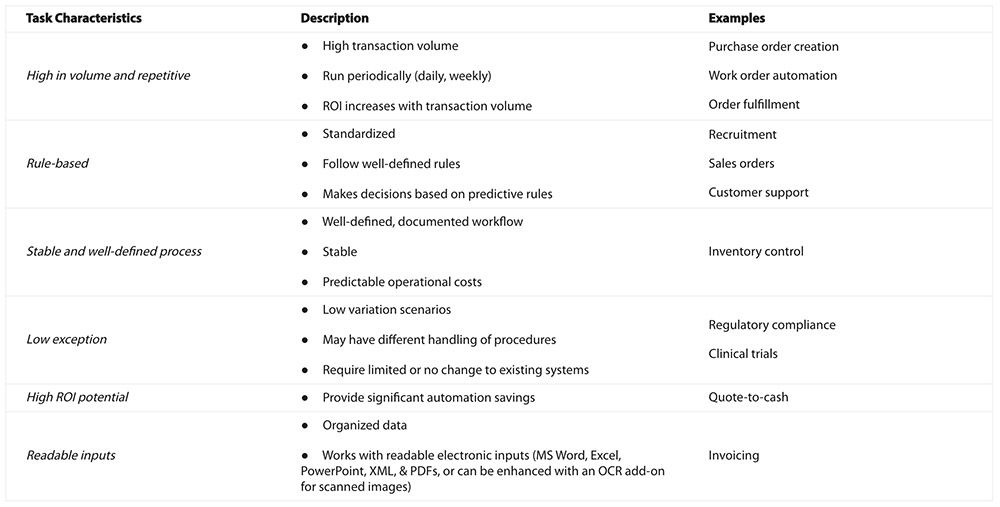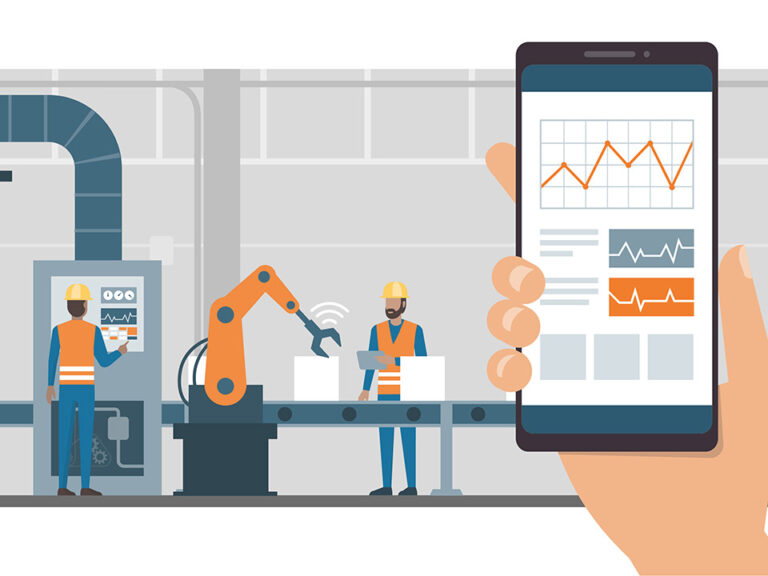A Beginner’s Guide To RPA For Manufacturing
RPA transforms your manufacturing sites by reducing costs, increasing productivity, removing waste—in terms of time, effort, and resources—from your processes, and maximizing ROI. See how software robots make this possible for purchase order creation, inventory control, clinical trials, lab testing, work order automation, and more.
An Office Workers Survey found that 58% of employees believe their jobs don’t allow them to be as creative as they’d like to be. Workers waste up to five business hours a week on routine processes—which they think could be automated.
Like other industries, manual processes are still prevalent in manufacturing.
Simple, repetitive tasks such as data entry, updating user permissions, or invoice processing can gum up the works and waste thousands of person-hours.
That’s where robotic process automation (RPA) comes in.
RPA is a software technology that comprises software robots, or “bots,” which mimic human actions to carry out a task within a process. RPA can do repetitive stuff faster, more accurately, consistently, and tirelessly, freeing employees for more complex assignments.
Automation technology also reduces the average process cost and saves businesses thousands of work hours annually. So, it’s no surprise that 41% of businesses in the manufacturing/engineering industry will implement RPA by 2025.
To help you understand RPA’s full value, this guide will cover everything you need to know about RPA for manufacturing and how to implement it in your business.
THE BENEFITS OF RPA FOR MANUFACTURERS
There are already 2.7 million industrial robots operating in factories around the world, which complement human workers in the factory assembly line.
However, as customer expectations and competition increase, manufacturers are seeking ways to streamline their operational processes and back-office tasks.
RPA delivers measurable benefits in business operations and outcomes—think greater accuracy, speed, efficiency, cost reduction—making processes and back-office systems just as efficient as the production lines.
For manufacturers, RPA helps:
- Improve productivity
- Reduce back-office costs
- Make business processes lean
- Maintain an audit trail
- Drive product innovation
- Decrease go-to-market time
- Meet customers’ expectations
IMPROVE PRODUCTIVITY
RPA bots are powerful digital assistants that free factory employees at every level from routine processes.
As a result, employees have more time to do what they do best—solving problems, conducting analysis, improving processes, and other value-added work.
The reduction in menial tasks increases employee engagement and productivity, which translates to bigger achievements, more satisfied customers, and happier employees.
MAS Holdings wanted to compound growth across its operations and increase market competitiveness.
The company, which has over 99,000 employees in its 53 manufacturing facilities across 16 countries, expedited its digital transformation by implementing automation of its product, procurement, shipping, and commercial processes through RPA.
Automation technology took out chunks of repetitive, non-productive tasks from MAS employees’ time, resulting in 14,000 work days saved annually and increased motivation among the workforce.
REDUCE BACK-OFFICE COSTS
Increasing cost pressures on manual and highly repeatable tasks pushes manufacturing companies to improve operations significantly.
RPA bots have a 24/7 functioning capacity, which means they can replace much of the manual work required to complete ordinary, duplicate services and reduce back-office costs.
If executed properly, automation can reduce the need for a large workforce, increase efficiency, and generate a positive ROI. In fact, McKinsey found that the most successful automation transformations allow companies to achieve 20%-40% efficiency gains and a positive ROI in 12 to 18 months..
Coupled with artificial intelligence (AI) , RPA eliminates human error, makes supply chain processes more agile and increases compliance.
MAKE BUSINESS PROCESSES LEAN
RPA helps manufacturers eliminate workflow and process waste in terms of time, effort, and resources across the organization. That way, things can run smoothly and flawlessly, and you can deliver more value to your customers.
RPA can push for process standardization, which ultimately re-engineers and optimizes your processes.
For instance, onboarding new hires is usually “choppy” and split between multiple departments in the organization—each with their own process tasks. Most times, this happens because of confidentiality of some personal data, which is exclusive to human resources (HR) teams. Other departments involved in the onboarding process have to wait for HR to create employee IDs before proceeding further.
RPA bots can seamlessly tap into the HR database, and security and IT systems, making the onboarding process less error prone and much more efficient. These bots are often more cost effective, especially where your organization has some of its back-office processes in offshore locations.
By making your processes lean, RPA helps:
- Reduce waste
- Ensure quality growth
- Check which process adds value and which one doesn’t
- Generate faster results
- Free employees to use their talents for more valuable work
- Obtain the ultimate operational excellence
- Maximize your ROI
MAINTAIN AN AUDIT TRAIL
When the output of a process produces an unexpected result, an employee may not quickly or easily identify it.
RPA not only performs routine tasks in an error-free, consistent manner, but it also provides an audit trail of work performed so you can identify any anomalies or red flags.
For instance, if your business is often out of compliance with manufacturing regulations due to manual, error-prone processes, RPA automates different aspects of those processes, with greater accuracy than human workers, while recording all its steps.
An audit trail shows details such as date, time stamp, activity information and type, machine ID, bot/process name, system name and activity, job ID, and more.
DRIVE PRODUCT INNOVATION
Besides reducing costs and enhancing scalability for your business, RPA also spurs product innovation.
By passing the dreary, menial tasks to software robots, you can leverage the full brain power and focus of your employees.
RPA empowers workers to use their skill-sets on business needs that drive value, which machines or bots cannot replicate. The technology augments employees’ existing capabilities, freeing them to be creative and innovative while increasing engagement and fulfillment in their roles.
DECREASE GO-TO-MARKET TIME
Effective manufacturing operations focus on:
- Designing and creating a great product
- Getting the product into the customers’ hands
Before automation, manufacturing processes required significant manual work—an already slow process.
Deploying RPA’s digital workforce executes processes faster and with greater accuracy. Automation transforms testing and quality control processes, reducing human error risks to nearly zero.
Activities that previously took days can be completed in minutes, thanks to streamlined processes and automated routine tasks.
MEET CUSTOMERS’ EXPECTATIONS
As the number of orders and updates grows, processes can quickly become chaotic, meaning more room for errors to compound and higher chances of costly downtimes.
It may be challenging to keep the many pieces of your manufacturing process moving swiftly without software robot assistance. RPA bots work seamlessly across your manufacturing systems, instantly processing and analyzing real-time data.
You can generate important new insights from the real-time data to help you predict drivers of business performance.
RPA also keeps your processes and service lines efficient to serve your customers in a timely fashion and offer a better customer experience.
RPA’s Use Cases In Manufacturing
The best way to understand RPA is to know what problems it can solve.
Manufacturing has several business functions besides administrative work, most of which involve tasks that RPA can automate.
Below is a list of some of the manufacturing processes an RPA solution works well for.
1. PURCHASE ORDER CREATION
Some manufacturing companies still rely on 24/7 staffing to fulfill purchase orders every day. This is not only time-consuming and tedious, but it impacts other parts of your operations and may cause downtime.
Employees face several personal and work-related issues—late arrivals, absenteeism, loss of resources, or family emergencies—which delay timely product delivery to your valued customers.
Whether your business generates hundreds or thousands of purchase orders each day, RPA can automate the purchase order creation process.
RPA bots efficiently generate purchase orders based on priority (significantly reducing turnaround time) and send reports via email to each client.
- Reduce your dependence on manual labor
- Boost productivity
- Successfully meet client demands
- Increase customer satisfaction
Levi Strauss & Co., for example, rolled out a Purchase Order Closure bot to automate and scale the number of purchase orders its finance team can close out.
By leveraging bot technology across its operations to sift through all open purchase orders and close out the addressed orders in a timely fashion, Levi’s was able to:
- Save time for its internal teams and external vendors
- Empower its finance team to reconcile purchase orders each quarter rather than annually
- Get an accurate understanding of the company’s overall budget and finances
- Have time for other relevant projects
2. ORDER FULFILLMENT
Order fulfillment comprises all the processes from the moment a customer places their order until delivery. For manufacturers, this process has always been a pain point.
On paper, order fulfillment is entirely rule-based. So, it should be error-free. But, the reality is different.
A typical order sets off a chain of events that manufacturers must execute flawlessly and deliver to their customers on time. Often, it goes awry.
Errors can often come from simple human oversight, like missing a postal code from the client’s details. And not all agents maintain the same pace of process execution or have timely access to information.
Delays may also occur in decision-making and handoffs between teams, which lead to late or unfilled orders. As a result, your business loses customers and revenue.
But this need not be the case. RPA can automate and create a flawless order-to-activate process. Specifically, software bots will:
- Identify order notifications and emails
- Download order requirement files
- Extract relevant order information and client details
- Update order fields
- Create an order in your Enterprise Resource Planning (ERP) system
- Reply to clients with information on product availability and shipping options
A key advantage of this automated process is that the bots proactively and continuously improve your order fulfillment process.
Bots also capture each process metric so your analytical engines can pick up any anomalous processes, identify failures in advance, and take measures to bring such incidents back in line.
Faster order entry times, greater accuracy, and increased transactions can mean earlier revenue realization, reduced operational costs, better compliance with regulatory bodies, and increased customer satisfaction.
3. INVENTORY MANAGEMENT
Inventory control is at the core of the supply chain, ensuring that your company always has the raw materials, components, and products on hand while keeping costs low.
Yet manufacturers still grapple with inventory control issues like stock-outs, dead stock, high storage costs, inefficient tracking, and misplaced inventory items.
RPA can automate repetitive tasks, such as demand prediction, stock replenishment, inventory allocation, and deliver them with accuracy. That way, you can reallocate your employees to tackle more complex processes.
The software bots:
- Monitor your inventory
- Notify you when inventory levels are low
- Reorder products that fall below a specified threshold
- Provide real-time reporting
- Determine optimal inventory levels based on previous needs
- Modify inventory levels based on demand patterns
You no longer have to close shop for manual stock-taking. RPA organizes the inventory control process, making it convenient for you to retrieve inventory levels and assess your current needs.
During the global pandemic, Standard Manufacturing faced fluctuating demand for cleaning and sanitizing products. This made it harder for the company to manage its operations, forecast accurate demand for inventory, and optimize production.
After implementing RPA, the company experienced 2.7x year over year (YoY) improvement in inventory turnover and a 28% increase in revenue.
4. VENDOR COMMUNICATION
Communication in the manufacturing industry can be time-consuming, especially if you manage multiple office branches and factories.
The entire communication loop requires lots of manual effort as your customer representatives handle a wide range of queries via phone, email, customer support apps, and other channels.
RPA bots can automate name recognition, automatic email replies, language detection, and chatbots. Plus, they can effortlessly monitor, access, and update changes within the manufacturing system so you can experience faster communication with suppliers.
Typically, a software bot will:
- Open the email
- Read the text from the vendor
- Download any attachments (if needed)
- Log into your ERP portal
- Determine the status of the order/shipment
- Reply to the vendor
Unless there are some exceptions, the entire process doesn’t need human intervention. So, you can eliminate manual effort from your vendor communication process, enabling your customer support reps to resolve more queries in less time.
5. CUSTOMER SUPPORT AND COMMUNICATION
Customer support is vital to the success of your manufacturing business.
Deploying RPA allows your customer service agents to access data from various systems in one place instead of navigating multiple screens when responding to customers. Software bots offload repeatable tasks from your agents so they can focus on more complex and nuanced issues.
There are two RPA approaches you can apply to customer support and communication:
- Implement a computer telephony integration (CTI) to reduce the volume of (low-complexity) issues routed to human agents: This approach redirects calls to an agent only when the bot cannot resolve the request by itself.
- Use attended bots as digital assistants to your agents: This approach reduces your agents’ processing time per call, making them more efficient.
For maximum impact, you can combine both approaches – bots and humans working together to help your support team be more effective and improve the quality of service to your customers.
Bridgestone-Fujitsu’s Thailand subsidiary adopted RPA to increase work efficiency, improve customer service, and create new business value.
The company saw a 50% reduction in manual processing and errors occurring from manual data filing and document preparation. Plus, it saved 90% of its operation time (from 4 hours to 2 minutes) and 85% of paper (from 700 to 100 pages), and improved their customer satisfaction with faster service.
6. REGULATORY COMPLIANCE
There are many direct or indirect compliance regulations and practices in the manufacturing industry, such as product safety, health controls, employment law, IT safety and security, and data protection.
In recent years, the risk of non-compliance has become a big concern, especially for manufacturers with operations in multiple jurisdictions and countries.
The emergence of global manufacturing compliance standards and the increasing role of governmental regulatory bodies makes it even more challenging for manufacturers to meet the growing array of regulations.
Automation allows you to stay compliant by:
- Providing improved oversight and control over your operations: Software bots’ actions are saved into a log where you can review and monitor them anytime.
- Offering greater accuracy and higher compliance levels: Once you establish a process as an automated workflow, it’ll be executed the same way without errors regardless of the task. That way, you can maintain better levels of compliance for all processes.
- Increasing your company’s auditability: Legal compliance audits don’t happen regularly, but passing these audits is critical to your business’s success. With RPA bots’ actions saved into an activity log, you’re better prepared for external audits whenever they arise.
RPA helps support and maintain your compliance programs so you can reduce legal issues, improve business operations, and retain employees and customers.
7. BILL OF MATERIAL GENERATION
A Work Order is the first step in the manufacturing process that sets the stage for the shop floor to meet item production demands based on the specifications defined in the Bill of Materials (BOM).
Work Orders provide details about the work to be completed, including the tools needed, skills requirements, and location.
It can take a lot of time for a human worker to review the BOM, gather the required information, and determine what to purchase and where to purchase it from. Otherwise, it’ll be nearly impossible to build complete and shippable products.
“Work Order creation is still a manual process, which is created by a manufacturing planner, or a daily requirement of work orders based on unavoidable circumstances. It requires skilled and technical knowhow to apply it within an ERP.” – Dee Shawn, Leaniar VP for Delivery.
Any errors at any of the Work Order or BOM review phases can adversely impact the production cycle, resulting in massive losses for your business.
With RPA, your production team doesn’t need to review the BOM manually. Instead, they’ll email the RPA bot with basic fields like:
- The item to build or assemble
- Quantity to be produced
- Start date
- Manufacturing branch or location (you can map locations based on the person sending out the Work Order)
The bot will pull the required details from the BOM with increased accuracy and in a fraction of the time.
RPA automates this backbreaking, error-prone process by handling the BOM in real-time, ensuring that you manufacture products without defects and ship them on time.
Automation also improves the accuracy of results in your cycle counting process while providing trust in stock levels and enabling real-time visibility as inventory changes. Avoiding inaccuracies can save your business extra costs for unusable components that can affect your bottom line.
8. LOGISTICS AND TRANSPORTATION MANAGEMENT
Slow and inefficient logistics processes lead to unhappy, dissatisfied customers.
Logistics processes are the backbone of many manufacturing companies.
Typically a manual field, logistics has a high automation potential. But the sector is gradually improving its use of data as customers demand for products quickly, and at competitive prices.
Yet, 79% of manufacturers still use pen-and-paper manual processes to handle what happens on the shop floor and their logistics.
Handling processes like picking orders and booking transport leaves them prone to costly, time-consuming errors. For example, an employee might create a delivery for the wrong number of items or book an urgent air freight instead of a month-long sea shipment.
RPA automates manual logistics and transportation tasks, which helps reduce errors and increase efficiency in your logistics process by:
- Providing a real-time, fact-based overview of your process so you can identify any bottlenecks or weaknesses
- Monitoring and streamlining all logistics to track costs and outcomes across carriers
Insights from the RPA process can help you decide whether to transfer production to a different location based on demand or standardize shipping terms and freight costs.
9. ACCOUNTING AND FINANCE
For manufacturers, closing the books is a unique and complex process.
You must rely on local sites or plants to complete critical closing steps. Each location can have spreadsheet-driven processes and fragmented systems, so there’s no standardization across accounting processes.
RPA automates the rule-based, manual, and repetitive transactional activities like copying and pasting data, VLOOKUPs, multiple Excel tabs and files, and rainbow spreadsheets in your processes with greater accuracy.
Automation saves time spent on such transactional activities, reduces the cost of accounting operations, and reduces the risks from an already complex close process.
Using RPA enhances compliance in your internal controls while helping you retain employees who would otherwise be disengaged due to repetitive work spent in spreadsheets.
Some accounting and finance processes you can automate may include:
- Reconciling external inventory reports against internal systems
- Capturing and comparing logistics events against costing and shipping terms
- Classifying inventory (raw materials, work-in-process, or finished goods)
- Accruing for fluctuating supply chain costs
- Clearing open item managed accounts for transactions like cash, prepaids, accruals, and T&E
- Reconciling procure-to-pay transactions that involve data from purchase orders, supplier invoices, and payments
Scania Group, a leading transport solutions provider with 51,000 employees in over 100 countries, implemented RPA to automate invoice processing.
Initially, each of its finance departments spread across the world would use manual processes involving Excel files to check and validate information, and send those files to their shared service center.
RPA helped Scania achieve 80% reduced transaction time in invoice processing. What took a human five minutes per invoice now happens in less than a minute. Plus, the company can improve the quality of the data flowing into its business systems.
10. CLINICAL TRIALS
Manufacturing companies that conduct clinical trials deal with multiple challenges in a highly regulated, compliance-driven industry.
Clinical trials are tedious, time-consuming, and generate large amounts of data, which you have to collect, analyze, and store for easy access.
RPA streamlines clinical trials by automating repetitive, rules-based, and error-prone tasks. Such mundane tasks include filling out records and documents, sending automatic notifications, making schedule entries, transferring data between systems, and ensuring data compliance.
Automation speeds up these tasks and improves results’ accuracy. You can optimize each step of the clinical trials faster while reducing the risk of clerical errors and improving overall process efficiency.
For example, a pharmaceuticals company can apply RPA in several clinical trial phases, including:
- Patient matching and retention
- Trial master file management
- Site management tasks (contracts, payments, and monitoring)
- Regulatory management affairs
- Case processing
- Logistics (biological sample, drug, and clinical supplies)
Better data from your clinical trials means better product quality and a higher chance of approval from regulatory agencies.
ICON plc automated the drug and device development process to battle declining ROI.
The organization implemented RPA bots to capture routine clinical and operational data, test it to flag safety issues, assess potential data entry errors, and forward clean data to the trial master file.
RPA enabled ICON plc to:
- Save thousands of hours
- Reduce the average $2 billion development costs for each new drug
- Ensure 100% accurate clinical data processing
- Update 60,000 clinical report forms in 30 hours (twice as fast as a human)
- Achieve a 45% reduction in document processing cycle times
11. AUTOMATE LABORATORY TESTING PROCESSES
RPA can also automate laboratory testing processes, data from clinical trials, and research to speed up participant recruiting and enable patient monitoring.
Software bots integrate the data from your systems, automate manual processes, and extract document information.
RPA bots can also track safety issues in products or raw materials and specimens. Pharmaceutical companies, for example, can leverage RPA real-time data for pharmacovigilance and complaint handling.
What Kinds Of Tasks Are Good Candidates For RPA?
“Manufacturing clients bring a unique challenge, as there are many more transactions to capture, to accurately manage and maintain a site. Transactions are not only at the manufacturing operations but also in the Supply Chain, HR, Finance and Accounting, Customer Service, IT, etc. RPA combines speed of deployment, quality of solution and low total cost of ownership into one platform which can automate both front-office and back-office operations in your business. It’s the most complete and agnostic automation platform we have implemented so far” – Dee Shawn, Leaniar VP of Delivery.
Here’s a list of characteristics that make a task or activity suitable candidates for RPA.
Let Leaniar Help You Automate Intelligently
You’ve learned a lot about the benefits and use cases of RPA for manufacturing. It’s your time to start and scale RPA.
With the right RPA automation operating model, you can quickly deploy software bots, reduce costs, and free your employees for more strategic, and innovative projects.
Leaniar’s intelligent, lean, and rapid RPA solution for businesses in the manufacturing industry helps you add speed, increase efficiency, and drive revenues across the value chain.
We’d love to help you along your automation journey.
Contact us today to find out how Leaniar can help position your manufacturing business for a future workplace fueled by automation.







